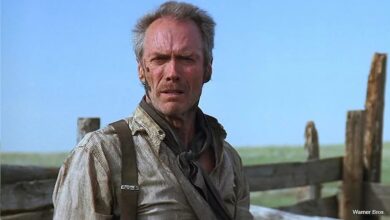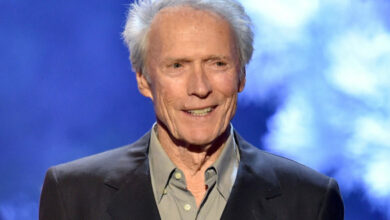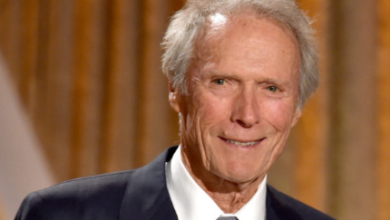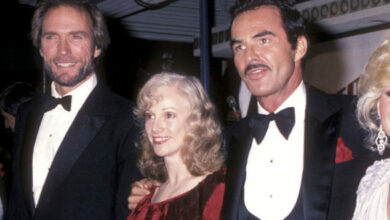High Plains Drifter: Clint Eastwood reinvents his iconic ‘Man with no Name’ as a quasi-supernatural avenger in this eerie western
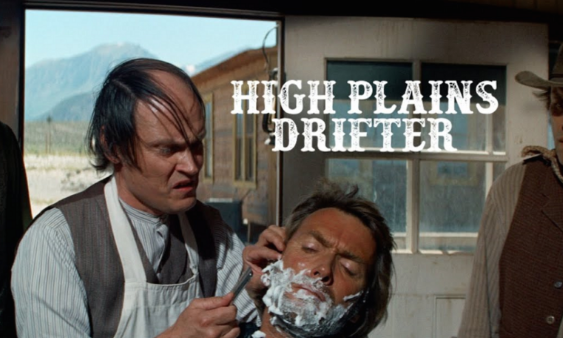
High Plains Drifter(1973) is the first Western that Clint Eastwood directed. It’s a little different from the rest of the westerns he made, as an actor or as a director, as it plays out more as a supernatural thriller.
“That isn’t what the West was all about. That isn’t the American people who settled this country.” – John Wayne on High Plains Drifter

It might appear a little ominous to start talking about a western with a quote bashing the movie and that too from legendary western Icon John Wayne. But we are discussing a rather strange movie that polarizes the audiences, and Wayne’s reaction is a pointer towards that. To put Wayne’s quote in context : John ‘Duke’ Wayne and Clint Eastwood have a lot in common. They are ‘the‘ two biggest movie stars of all time. Both extremely prolific and long lasting. Both became icons through their perfect embodiment of the Archetypal American male in the most popular American film genre of the ‘Western‘ . They are both blessed with ruggedly handsome looks and a towering personality that makes them perfect for these films that unfold against the grand vistas of American frontier wilderness. Both of them had a couple of great directors helping them in shaping their iconography at various stages of their career. For Wayne, it was John Ford and Howard Hawks ; For Clint, it was Sergio Leone and Don Siegel. Above all, both are politically conservative. So, with so much in common, one would obviously assume that Duke had a great deal of admiration for Clint, who could be considered his heir apparent. Not so i am afraid, professionally at least as it is obvious from Wayne’s feelings about Clint’s 1973 film High Plains Drifter quoted above. The main reason for this was: American west that was presented in Duke’s films was very different from the ones that we got to see in Clint’s films. Duke came of age as a star in the triumphant years of 1940’s and 50’s . His films were concerned with the glories of the white man who settled the west. They are portrayed as pioneers who brought modernity and prosperity to the resplendent landscape that was under the savagery of the Native American tribes. On the other hand, Clint attained stardom in the counter-cultural, swinging 60’s which was a period of revisionism . His Westerns were more about the schism, the violence and the savagery that existed within the, so called , modern society that replaced the primitive tribal society. Duke, like the characters he portrayed, wholeheartedly believed in the nobility and the adventurous spirit of the white settlers who went west and brought with them the benefits of modern civilization and established modern towns and cities. But, by the time Clint came long , the concept of the ‘savage injun as the bad guy‘ was passé. Even great western auteurs like John Ford were making their own ‘mea culpas’ like Cheyenne Autumn during this period. In Clint’s films, the settlers are portrayed as mean, morally corrupt, violent and no more civilized than the natives. So it’s natural for Duke to have a certain extend of disdain for Clint’s movies. Also, Duke’s characters (with some exceptions) never lost their moral center. They operated within the strict parameters of what is universally perceived as right and wrong. He never shot anybody in the back. He was also adamant that when he shot someone, the action has to be cut in such a way that we never see the gun being fired and the recipient of the bullet being killed in a single shot. Clint, on the other hand, would go on to break every one of these rules. Sergio Leone’s A Fistful of Dollars, the film that made Clint a star, would be the first film where we saw the gun being fired and people being shot down in the very same frame. And Clint had no scruples about shooting people in the back either. His characters are only concerned with their own survival . There’s an interesting story that happened on the set of Duke’s last film The Shootist , which was directed by Clint Favorite Don Siegel. Siegel suggested that Duke shoot the villain in the back. When Duke balked at the suggestion, Siegel, rather un-diplomatically, let go that Clint would have shot the guy in the back . This comment enraged Duke and he fired back: “John Wayne never shoots anybody in the back, he is not like that new kid Clint Eastwood“. It was Clint’s big dream to do a film with Duke and he sent a letter to Duke expressing his desire to work with him. But Duke turned it down, responding with an angry letter, in which he denounced his films, particularly High Plains Drifter, for its violence and revisionist portrayal of the Old West. Eastwood did not bother to answer his criticisms, and consequently, the dream team-up never happened.

John Wayne’s criticism notwithstanding, High Plains Drifter is one of the most stylized, moody, bizarre and out of the box westerns ever made. Clint Eastwood’s first western as a director – He had already made his directorial debut with 1971 romantic thriller Play Misty for me – takes his ‘Man with no name’ Character, that he originated in Sergio Leone’s spaghetti westerns, to it’s logical extreme; which is to make it less a character and more an abstract supernatural force . A sort of the God from the old testament: the God of vengeance violently punishing the wicked and the immoral. Clint’s mysterious stranger– we never find out who he is or his name- emerges out of the morning heat haze from the high Plains and rides into the lakefront town of Lago. He is looked on with suspicion by the townsfolk and as we will come to realize soon, the town has a lot of dirty secrets to hide and it’s natural for them to be suspicious of strangers. On his arrival, Clint takes a ride through the entire town observing every nook and corner . His dispassionate self is suddenly awakened when he hears the sound of a carriage-driver whipping his horse. It appears that the moment has awakened some bad memories in him . Finally, when he reaches the end of the town- interestingly, where the undertaker seems to keep the coffins- he gets down, tie his horse and goes into the saloon for a drink. He gets a rather hostile reception inside the saloon, especially from three guys who appears to be gunfighters. After some tense conversation with the three, Clint walks out and goes into the barbershop for a shave. The three guys follow him there and try to rattle him, but he surprises them with a fast draw. He shoots down all three of them; the first one gets it between his eyes, the other two are shot through their heart. The Barbershop is partially demolished in all this action. Clint, nonchalantly, wipes the soap of his face, picks up his hat and walks out. On his way out, Clint is hit on by town tart Callie Travers(Mariana Hill). When he refuse to respond to her overtures, she slaps him. An angry Clint drags her into the nearby livery stable and rapes her. He then coldly walks out and rents a room in the town hotel, owned by Lewis Belding(Ted Hartley) . Once in his room, he beds down, and as he is sleeping, he has a nightmare about a man being brutally whipped to death by three men.

So, within the first twenty minutes of this 105 minute movie, we already have murders, rape, destruction and horrifying nightmares. High Plains drifter was released the same year as the Dirty Harry sequel Magnum Force and it goes without saying that the Mysterious drifter of this film makes Dirty Harry look like a pacifist. As it is obvious from the opening , the film is heavily influenced by Clint’s ‘Dollar‘ films with Sergio Leone . The revisionism , the amorality and the mystique of the man with no name seems to have been borrowed from Leone’s westerns. But as the film progresses, Leone’s influence wane and Don Siegel’s -Clint’s other mentor – influence takes over. Clint retains Leone’s grittiness, dark humor and the iconography of the lead character, but, cuts down on the operatic exuberance and flamboyance, choosing to make a more leaner, minimalist and dark gothic western. The plot of the film could be broadly summarized as ‘High Noon on steroids’, after the iconic 1952 Gary Cooper western High Noon, where we had the Sheriff played by Cooper being abandoned by the townsfolk as three cutthroats, (whom the sheriff has send to the prison) return to take revenge. By the way, High Noon was another film that Duke despised. So it’s no surprise that he was pissed at High Plains Drifter. Duke and Director, Howard Hawks, had made Rio Bravo(1959) as a retort to High Noon, which was a more heroic and optimistic version of the High Noon story.

High Plains Drifter follows a plot similar to that of High Noon, except here, the town Marshall, Jim Duncan, is whipped to death by three cutthroats – Stacey Bridges and The 2 Carlin brothers- with the tacit approval of the townsfolk to cover-up a secret that would seriously damage the economic prosperity of the town. It seems that the coalmine that feeds the town is on federal land and the Marshall had plans to spill this truth to the authorities. Now the Marshall taken care of , the town betrays the murderous threesome, and have them imprisoned for some petty charge of stealing gold from the coal mining company. But now that the threesome has finished their sentence, the townsfolk knows that they would be coming directly to Lago to take revenge. To counter this, they hire another threesome to defend them; unfortunately, the same threesome that Clint kills in the opening. Now the town begs Clint to become their protector. Clint initially declines. But the town is desperate and they promises him anything he wants, unlimited credit in every shop and saloon in town.

Though the film never makes it clear, it drops some hints as to who this mysterious stranger could be. One of them is that he is the ghost of the murdered Marshall, whose corpse is lying in the cemetery in an unmarked grave. The ghost has now come back to take revenge. The frequent nightmares that the stranger is having , about a guy being whipped to death, resembles the death of Marshall Duncan. Marshal Duncan, from whatever we could make out of him, resembles the stranger a lot (the role was played by Clint’s stunt double to accentuate this resemblance). The original script concept was that the stranger is the brother of the Marshall, but Clint decided not to reveal anything explicitly, and let the audience draw their own conclusions about the character. He wanted to keep it as a sort of biblical morality tale, where people who does bad things have to pay for their actions. Clint amps up the spooky nature of the film wherever he can, making the audience feel that they are watching a supernatural\thriller western rather than a traditional one. And the stranger comes across as supernatural too. He appears impervious to bullets and is devoid of any form of human emotions. Additionally, he seems to be holding some fierce grudge against the town. He becomes the town’s protector mainly to torment the townsfolk.. He puts the ‘unlimited credit ‘ offer to good use; He grabs himself a bunch of cigars, and proceeds to inflict detailed pain and embarrassment to the cowardly folks of the town. He gives blankets away to Indians, hires Mexican workers to throw the coming outlaws a big picnic welcome, evicts everyone from the town’s hotel so that he would be the lone occupant, makes the town midget, Mordecai, both Mayor and Sheriff, and then sees to it that the town is painted blood red and re-dubbed Hell. It soon begins to dawn on some of the townsfolk that the person from whom they need protection is the stranger and not the oncoming threesome. So, under Lewis Belding’s leadership, a few of them concoct a plan to kill the stranger. But the plan backfires and ends up destroying Belding’s hotel and killing a whole lot of them . Now the only place left for stranger to sleep is Belding’s bedroom . After ordering Belding and the others to bury the dead, the stranger grabs Belding’s wife, Sarah(Verna Bloom), and drags her into the bedroom. But he doesn’t rape her, as she feared, or show any interest in her , but still , Sarah succumbs to his charms and ends up sleeping with him.

Next day is the day of the showdown. We have seen in the interim the murderous threesome killing and stealing horses on their way to the town. Sarah, who by now have warmed to the stranger, and believes that he has some personal connection to the dead Marshall, tells him the truth about what really happened to the late Marshall. She’s had enough of living with her weak and cowardly husband and decides to leave Lago for good. Meanwhile, the stranger goes out into the wilderness and scares the hell out of the murderous threesome- who are camped just out of town- with dynamite and gunfire. He returns to the town , asks everyone to be ready and rides away. It appears that he is deserting them and leaving the town at the mercy of the killers. Stacey Bridges and Carlin brothers ride in and take the town without much effort. They kill and burn down half the town and take the rest hostage in the saloon. And as they are mocking and torturing them, the stranger suddenly appears, as if out of thin air, and starts killing the threesome one by one. The first Carlin is whipped to death – exactly in the same fashion as the late Marshall , the other Carlin is hung and finally, Stacey Bridges is cold-bloodedly shot dead by the stranger. The entire action takes place at night, in pitch darkness, illuminated only by the inferno that has engulfed the town giving the whole scene an apocalyptic feel. The next morning, the stranger packs up to leave and as he passes through the cemetery, he comes across Mordecai hard at work. Mordecai asks him the same question that he has been asking throughout the film :”I never did know your name“, and the stranger replies: “yes, you do“, and as he rides away, the headstone on the grave comes into the frame, obscuring the stranger, and we see ,Marshal Jim Duncan – Rest in Peace, written on it. It’s also interesting to note that the stranger rides back in the same direction he came from, disappearing into the heat haze from which he emerged, meaning that he wasn’t drifting or passing through, as was the case with a lot of these ‘man with no name‘ movies, where we see the protagonist come in to the town from one direction and goes out at the end through the opposite direction. It appears that The stranger specifically came to this town on a mission , and now that the mission is accomplished, he is going back to where he came from. This is another interesting twist provided to the oft-repeated formula.

Clint shot the entire film at Mono Lake, California , in a tight schedule of just six weeks. Clint is renowned for such efficient productions. He doesn’t like to waste money or too much time on making his pictures and he always brings the film under-budget and under-schedule. A full set of the town was erected , so that both exteriors and interiors could be shot on location, which allowed Clint to have some lengthy shots and maintain their continuity; like the ones where Clint walks out of the hotel and into the street, still carrying on a conversation with Sheriff Sam Shaw. Clint’s films are not noted for their stylistic flourishes. He has always been a minimalist, who likes to shoot his films simple and straight. But perhaps it’s due to its subject matter, High Plains Drifter is one of his more baroque and stylized movies. He uses strange camera angles and lighting schemes to heighten the eerie quotient in the film. The climax is very reminiscent of his classic film Unforgiven(1992), that he made almost 20 years later, though that was a very different western from this one. Clint would revisit this sort of a biblical character in Pale Rider(1985), which has a lot of similarities with this film. By the way, Clint paid homage to his mentors in the final scene of the film. The two gravestones next to Marshall Duncan’s is marked Sergio Leone and Don Siegel. Another grave is marked with the name of director Brian G Hutton, who directed Clint in Where Eagles Dare. It’s like he buried all his directors before he embarked on his own directorial career. No wonder he once quipped “I buried my directors“.

